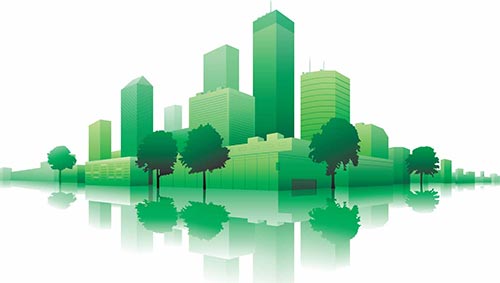Country profits from green building

Illustration photo Source: Internet
Worker sickness due to unhealthy conditions at shoe factories
Recently, instances of widespread sickness occurred in several Vietnamese shoe factories. In these cases, hundreds of workers from the same factory fell sick simultaneously. After these factories were examined by government experts, inefficient ventilation systems were cited as the main cause for the workers’ failing health. These workers suffered heavily from glue fumes circulating in the work area. This is a serious concern for workers’ health in the long run.
Fortunately, these cases of widespread sickness are not an issue in green or well-ventilated factories. A green factory will guarantee a low level of volatile organic compounds (VOCs), will be sufficiently ventilated, and will have a working environment that receives daylight.
Low volatile organic compounds
VOCs are organic chemicals with a high vapor pressure at room temperature. All green building certificates motivate project owners to use low VOC paints and other finished products. For example, the Singaporean Green Mark and the Vietnamese LOTUS both encourage the use of paints that have Green certification, while the American standard LEED evaluates the level of VOCs in a given environment to receive a score on this scale.
In fact, low VOC paints help protect the health of both painters and occupants. Painters’ health suffers if the paint they use is not low in VOCs. Paint with a strong smell is indicative of high VOCs, and is detrimental to the health of those who live or work in that space afterwards. LEED’s ‘flushing out’ method to eliminate chemicals in new buildings involves the use of high pressure fans to flush out all airborne chemicals and molecules to ensure a safe living environment prior to occupancy. If this practice is widely applied, I believe that indoor environment issues will be greatly improved in newly-constructed buildings and factories. People using these spaces for the first time will no longer suffer as a result of the harmful fumes and odours left behind by sub-standard paints and varnishes.
Fresh air
Fresh air is crucial to maintaining a healthy working environment. A lack of fresh air not only leads to lower working efficiency, it also is linked to the spread of diseases in the workplace. According to the WHO, over 30% of workplaces worldwide receive complaints from their occupants due to an unhealthy working environment. Unfortunately, the working environment in factories is the worst of all.
Green buildings must abide by ventilation requirements. Both LEED and LOTUS refer to ASHRAE in regard to the fresh air rate. It means green buildings must ensure a flow of fresh air by installing CO2 sensors. Once the air in a particular space becomes too burdened with CO2, the sensors activate a pump which draws more fresh air into the workspace.
Daylight and views
Daylight has been proved to be an important factor in improving the health and working efficiency of occupants or workers. Various studies how that people working in day-lit spaces have better and longer sleep at night compared with people working in a space without sunlight. Students studying in day-lit spaces also register better results than those who study in artificially-lit rooms.
Although views may not have any direct health benefits, they do bring certain comforts to building occupants, and people will evaluate a premises on whether it has a good view or not. A flat with a good view can be sold at 30% higher compared to similar flats without a view. Also, a hotel room with a good view can be rented at higher rate than normal rooms on the same floor. Of course, an office corner with good view is always saved for top managers. So there is no doubt that having a view in a working space makes people feel more comfortable, and this has a knock-on effect in terms of higher working efficiency and occupant satisfaction.
Ultimately, it is up to project owners to opt for merely energy efficiency, or to implement a comprehensive green building design. Thankfully, most owners now see energy efficiency as necessary because of their low operation expenses. Meanwhile, conventional buildings can suffer as a result of rising electricity prices. Nowadays, new project owners constructing green buildings with a healthy working or living environment see this not as an optional luxury, but as a sustainable development and a smart investment.
By Do Huu Nhat Quang - A founding member of GreenViet
What the stars mean:
★ Poor ★ ★ Promising ★★★ Good ★★★★ Very good ★★★★★ Exceptional
Latest News
More News
- The Kross ascends in Ho Chi Minh City's business heart (October 10, 2025 | 17:16)
- ESG-driven sustainability to define Vietnam’s green real estate (September 19, 2025 | 11:35)
- Tan Thuan Tower open for high value-added and innovative tenants (September 10, 2025 | 10:00)
- The new home of modern business at Hanoi's Starlake (August 19, 2025 | 08:00)
- Forum focuses on financial solutions for ESG in real estate (June 18, 2025 | 12:12)
- Frasers Property Vietnam moves towards green real estate leadership (May 08, 2025 | 11:25)
- Keppel collaborates with leading brands to enhance urban living in Vietnam (April 04, 2025 | 09:26)
- Strengthen partnership and efforts to promote zero energy buildings in Vietnam (February 26, 2025 | 17:31)
- Haus Dalat ESG real estate project holds opening ceremony (February 24, 2025 | 11:12)
- Best golfers awarded at Swing for the Kids 2024 (October 13, 2024 | 08:00)

















 Mobile Version
Mobile Version